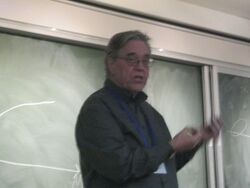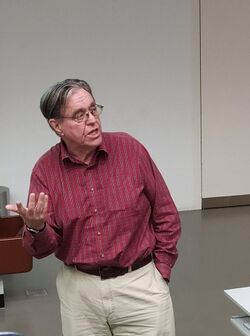Biography:David J. Stevenson
David John Stevenson | |
|---|---|
 David J. Stevenson, 2015 | |
| Born | 2 September 1948 |
| Alma mater | Victoria University (B.S., 1971) (M.S., 1972) (D.Sc) Cornell University (PhD, 1976) |
| Awards | H. C. Urey Prize (1984) Whipple Award (1994) Harry H. Hess Medal (1998) Richard P. Feynman Prize (2001) |
| Scientific career | |
| Fields | Planetary Science Earth Science Astrophysics Geophysics |
| Institutions | Caltech |
| Doctoral advisor | Edwin Salpeter |
David John Stevenson (born 2 September 1948) is a professor of planetary science at Caltech. Originally from New Zealand, he received his Ph.D. from Cornell University in physics, where he proposed a model for the interior of Jupiter. He is well known for applying fluid mechanics and magnetohydrodynamics to understand the internal structure and evolution of planets and moons.
Sending a probe into the Earth
Stevenson's tongue-in-cheek idea about sending a probe into the earth includes the use of nuclear weapons to crack the Earth's crust, simultaneously melting and filling the crack with molten iron containing a probe. The iron, by the action of its weight, will propagate a crack into the mantle and would subsequently sink and reach the Earth's core in weeks. Communication with the probe would be achieved with modulated acoustic waves.[1][2] This idea was used in the book Artemis Fowl: The Opal Deception.
Honors and awards
In 1984, he received the H. C. Urey Prize awarded by the Division for Planetary Sciences of the American Astronomical Society.
Stevenson is a fellow of the Royal Society and a member of the United States National Academy of Sciences.[3]
Minor planet 5211 Stevenson is named in his honor.[4]
See also
References and sources
- ↑ "bbc:Plumbing the Earth's depths". BBC News. May 14, 2003. http://news.bbc.co.uk/2/hi/science/nature/3021255.stm. Retrieved January 2, 2010.
- ↑ "A Modest Proposal: Mission to Earth's Core". http://web.gps.caltech.edu/faculty/stevenson/coremission/mission_to_core_(annot).pdf.
- ↑ "Origin of the moon | Royal Society" (in en-gb). https://royalsociety.org/science-events-and-lectures/2013/origin-moon/.
- ↑ "(5211) Stevenson". (5211) Stevenson In: Dictionary of Minor Planet Names. Springer. 2003. pp. 448. doi:10.1007/978-3-540-29925-7_5048. ISBN 978-3-540-29925-7. https://link.springer.com/referenceworkentry/10.1007%2F978-3-540-29925-7_5048.
External links
 |


